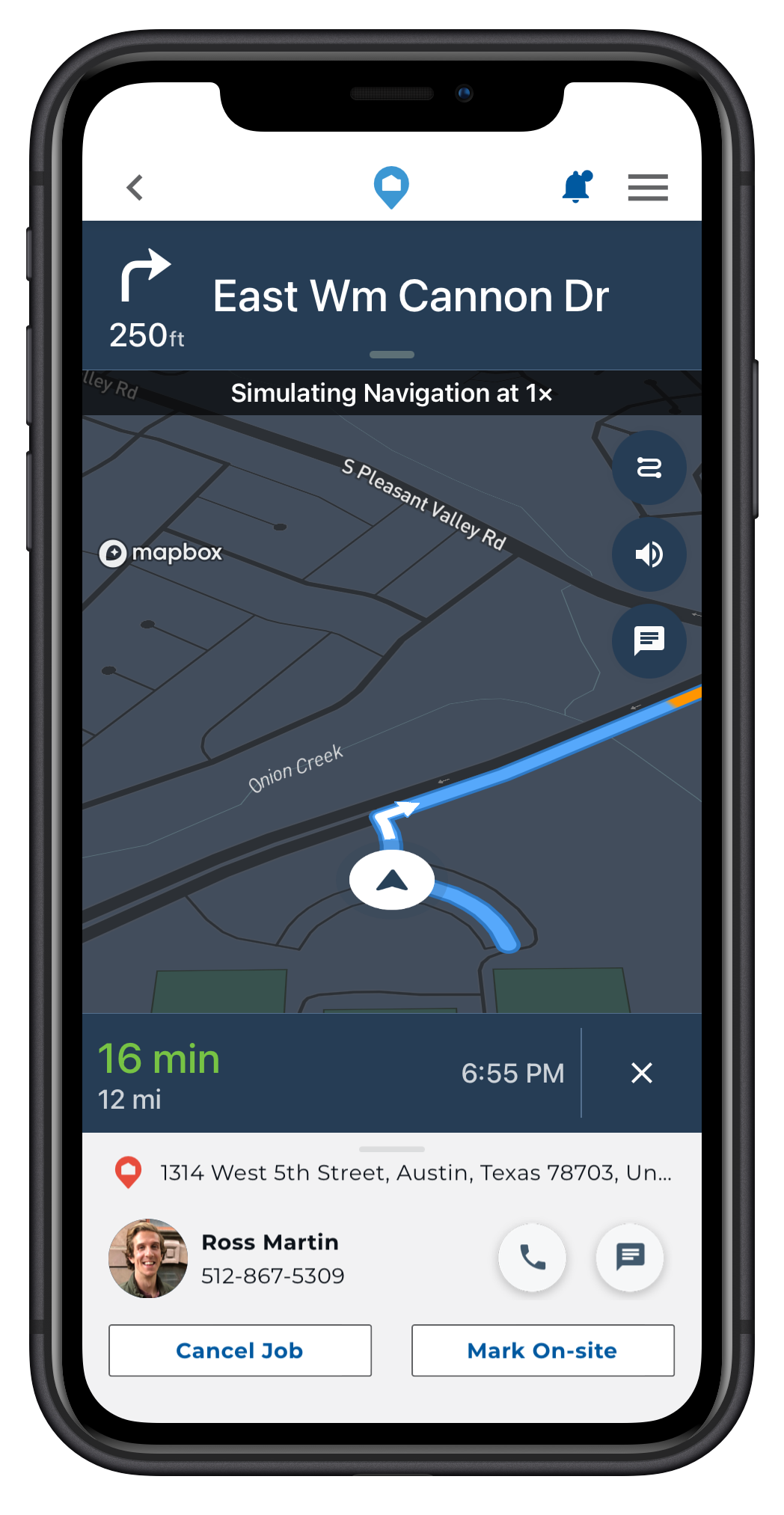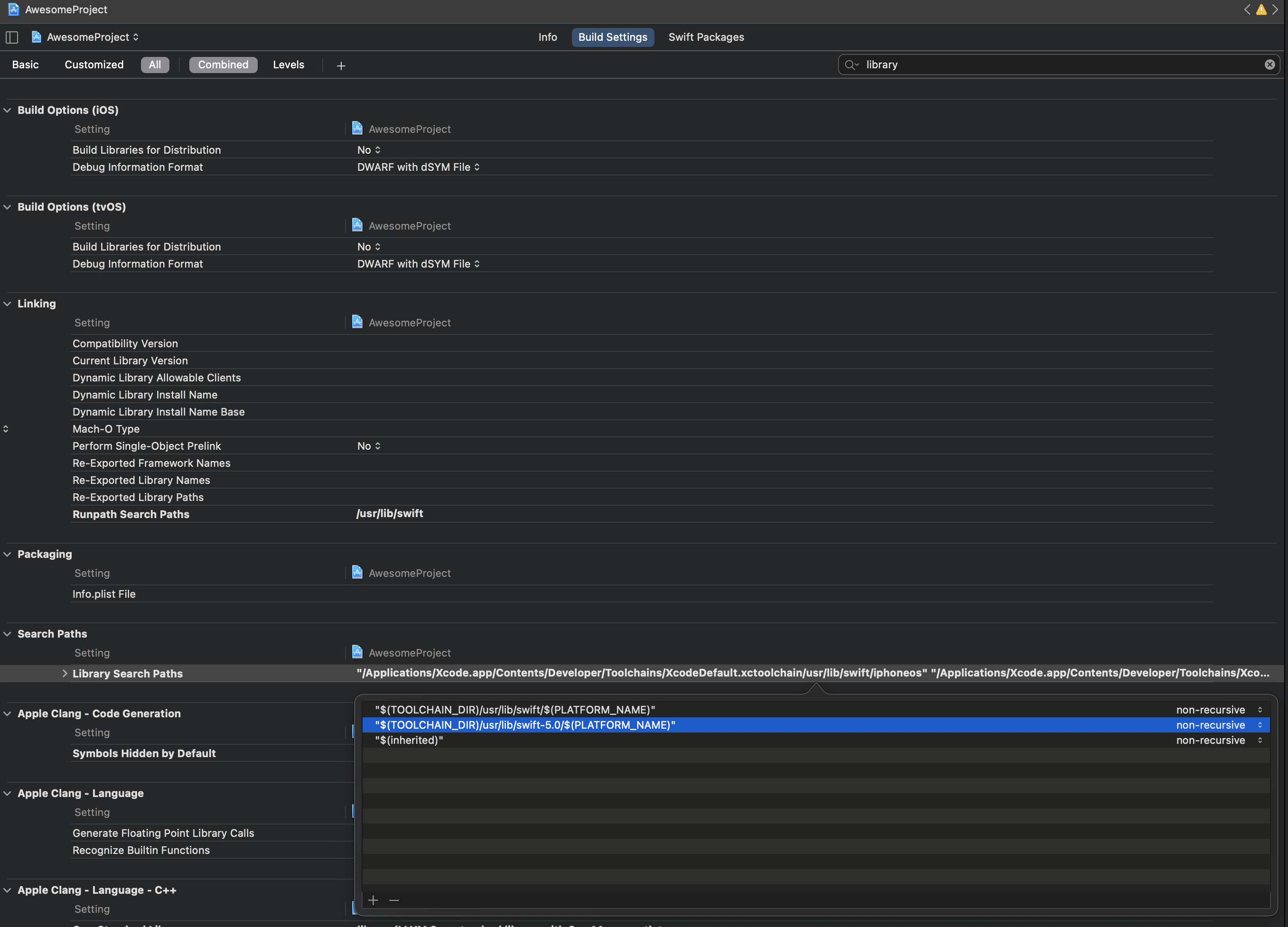React Native Mapbox Navigation
Smart Mapbox turn-by-turn routing based on real-time traffic for React Native. A navigation UI ready to drop into your React Native application. Sample demo usage shown here for the HOMEE Pro iOS app in the screenshot
Features
- A full-fledged turn-by-turn navigation UI for iPhone, iPad, and CarPlay that’s ready to drop into your application
- Professionally designed map styles for daytime and nighttime driving
- Worldwide driving, cycling, and walking directions powered by open data and user feedback
- Traffic avoidance and proactive rerouting based on current conditions in over 55 countries
- Natural-sounding turn instructions powered by Amazon Polly (no configuration needed)
- Support for over two dozen languages
Installation Requirements
Before installing the SDK, you will need to gather the appropriate credentials. The SDK requires two pieces of sensitive information from your Mapbox account. If you don't have a Mapbox account: sign up and navigate to your Account page. You'll need:
- A public access token: From your account's tokens page, you can either copy your default public token or click the Create a token button to create a new public token.
-
A secret access token with the
Downloads:Readscope.
- From your account's tokens page, click the Create a token button.
- From the token creation page, give your token a name and make sure the box next to the
Downloads:Readscope is checked. - Click the Create token button at the bottom of the page to create your token.
- The token you've created is a secret token, which means you will only have one opportunity to copy it somewhere secure.
Installation
npm install @homee/react-native-mapbox-navigation
Read the iOS specific instructions below before running pod install.
iOS Specific Instructions
Make sure your react native project has an Objective-C bridging header for swift. If you don't have a bridging header you can follow these steps here below in the dropdown.
Create an Objective-C bridging header
- From Xcode, go to:
File → New → File… - Select Swift File
- Name your file Dummy or whatever you want
- In the Group dropdown, make sure to select the group folder for your app, not the project itself.
After you create the Swift file, you should be prompted to choose if you want to configure an Objective-C Bridging Header. Select “Create Bridging Header”.
This file is usually named YourProject-Bridging-Header.h. Don’t change this name manually, because Xcode configures the project with this exact filename.
There are a few build settings in Xcode that are necessary. Make sure to set Don't Dead-strip Inits and Terms to YES and Dead Code Stripping to YES for all projects/targets.
You will also need to remove the entry "$(TOOLCHAIN_DIR)/usr/lib/swift-5.0/$(PLATFORM_NAME)" from Library Search Paths if it is present for your project target -
Place your public token in your Xcode project's Info.plist and add a MBXAccessToken key whose value is your public access token.
NOTE: MGLMapboxAccessToken is deprecated, now you should use MBXAccessToken instead
Add the UIBackgroundModes key to Info.plist with audio and location if it is not already present. This will allow your app to deliver audible instructions while it is in the background or the device is locked.
<key>UIBackgroundModes</key>
<array>
<string>audio</string>
<string>location</string>
</array>
Place your secret token in a .netrc file in your OS home directory that contains this:
machine api.mapbox.com
login mapbox
password <INSERT SECRET TOKEN>
Add the following to your ios podfile -
pre_install do |installer|
$RNMBNAV.pre_install(installer)
# any other pre install hooks here
end
post_install do |installer|
$RNMBNAV.post_install(installer)
# any other post install hooks here
endpodfile example
require_relative '../node_modules/react-native/scripts/react_native_pods'
require_relative '../node_modules/@react-native-community/cli-platform-ios/native_modules'
platform :ios, '10.0'
install! 'cocoapods', :disable_input_output_paths => true
target 'AwesomeProject' do
config = use_native_modules!
use_react_native!(:path => config["reactNativePath"])
target 'AwesomeProjectTests' do
inherit! :complete
# Pods for testing
end
pre_install do |installer|
$RNMBNAV.pre_install(installer)
end
# Enables Flipper.
#
# Note that if you have use_frameworks! enabled, Flipper will not work and
# you should disable these next few lines.
use_flipper!
post_install do |installer|
flipper_post_install(installer)
$RNMBNAV.post_install(installer)
end
end
target 'AwesomeProject-tvOS' do
# Pods for AwesomeProject-tvOS
target 'AwesomeProject-tvOSTests' do
inherit! :search_paths
# Pods for testing
end
endNow you are ready to install the cocoapod:
cd ios && pod install
If you are experiencing a "multiple commands produce" build error in your Xcode project then you will need to add this entry below to the top of your ios podfile:
install! 'cocoapods', :disable_input_output_paths => true
If you are having an issue with your archive not showing up in organizer after archiving then you will need to open ios/Pods/Target Support Files/@react-native-mapbox-gl-mapbox-static/@react-native-mapbox-gl-mapbox-static-copy-dsyms.sh and comment out lines 85 thru 89 -
Lines 85 thru 89
#install_dsym "${PODS_ROOT}/@react-native-mapbox-gl-mapbox-static/dynamic/MapboxMobileEvents.framework.dSYM"
#install_bcsymbolmap "${PODS_ROOT}/@react-native-mapbox-gl-mapbox-static/dynamic/93C58D95-90B9-30C8-8F60-4BDE32FD7E8E.bcsymbolmap"
#install_bcsymbolmap "${PODS_ROOT}/@react-native-mapbox-gl-mapbox-static/dynamic/BB87D8DD-493F-37AA-BD21-2BC609B8311B.bcsymbolmap"
#install_bcsymbolmap "${PODS_ROOT}/@react-native-mapbox-gl-mapbox-static/dynamic/B184533A-B4A2-3D2F-AD72-A6C33D9914F4.bcsymbolmap"
#install_bcsymbolmap "${PODS_ROOT}/@react-native-mapbox-gl-mapbox-static/dynamic/E2FE4B9E-73E5-34BF-B8B9-8FECEBE04D8D.bcsymbolmap"For more information you can read the docs provided by Mapbox.
Android Specific Instructions
Place your secret token in your android app's top level gradle.properties file:
MAPBOX_DOWNLOADS_TOKEN=SECRET_TOKEN_HERE
Open up your project-level build.gradle file. Declare the Mapbox Downloads API's releases/maven endpoint in the repositories block.
allprojects {
repositories {
maven {
url 'https://api.mapbox.com/downloads/v2/releases/maven'
authentication {
basic(BasicAuthentication)
}
credentials {
// Do not change the username below.
// This should always be `mapbox` (not your username).
username = "mapbox"
// Use the secret token you stored in gradle.properties as the password
password = project.properties['MAPBOX_DOWNLOADS_TOKEN'] ?: ""
}
}
}
}Place your public token in your project's android/app/src/main/AndroidManifest.xml
<!-- This should be a child of the application tag -->
<meta-data android:name="MAPBOX_ACCESS_TOKEN"
android:value="PUBLIC_TOKEN_HERE" />For more information you can read the docs provided by Mapbox.
Usage
import * as React from "react";
import { StyleSheet, View } from "react-native";
import MapboxNavigation from "@homee/react-native-mapbox-navigation";
export const SomeComponent = () => {
return (
<View style={styles.container}>
<MapboxNavigation
origin={[-97.760288, 30.273566]}
destination={[-97.918842, 30.494466]}
shouldSimulateRoute
showsEndOfRouteFeedback
onLocationChange={(event) => {
const { latitude, longitude } = event.nativeEvent;
}}
onRouteProgressChange={(event) => {
const {
distanceTraveled,
durationRemaining,
fractionTraveled,
distanceRemaining,
} = event.nativeEvent;
}}
onError={(event) => {
const { message } = event.nativeEvent;
}}
onCancelNavigation={() => {
// User tapped the "X" cancel button in the nav UI
// or canceled via the OS system tray on android.
// Do whatever you need to here.
}}
onArrive={() => {
// Called when you arrive at the destination.
}}
/>
</View>
);
};
const styles = StyleSheet.create({
container: {
flex: 1,
},
});
MapboxNavigation Props
origin (Required)
Array that contains the longitude and latitude for the starting point.
[$longitude, $latitude]
destination (Required)
Array that contains the longitude and latitude for the destination point.
[$longitude, $latitude]
shouldSimulateRoute
Boolean that controls route simulation. Set this as true to auto navigate which is useful for testing or demo purposes. Defaults to false.
showsEndOfRouteFeedback
Boolean that controls showing the end of route feedback UI when the route controller arrives at the final destination. Defaults to false. Currently this prop is only available for iOS as the Android Mapbox SDK does not support drop-in UI for this functionality. Will need to implement this manually in Android.
mute
Boolean that toggles voice instructions. Defaults to false.
hideStatusView
Boolean that controls showing the StatusView (iOS only). This is the transparent black bar with the "Simulating Navigation" text shown in the above screenshot. Defaults to false.
onLocationChange
Function that is called frequently during route navigation. It receives latitude and longitude as parameters that represent the current location during navigation.
onRouteProgressChange
Function that is called frequently during route navigation. It receives distanceTraveled, durationRemaining, fractionTraveled, and distanceRemaining as parameters.
onError
Function that is called whenever an error occurs. It receives a message parameter that describes the error that occurred.
onCancelNavigation
Function that is called whenever a user cancels navigation.
onArrive
Function that is called when you arrive at the provided destination.
Contributing
Contributions are very welcome. Please check out the contributing document.
License
The source code in this library is MIT licensed. The usage of this library will fall under Mapbox terms (this library downloads Mapbox SDKs and uses that closed source in conjunction with the open source code here).




